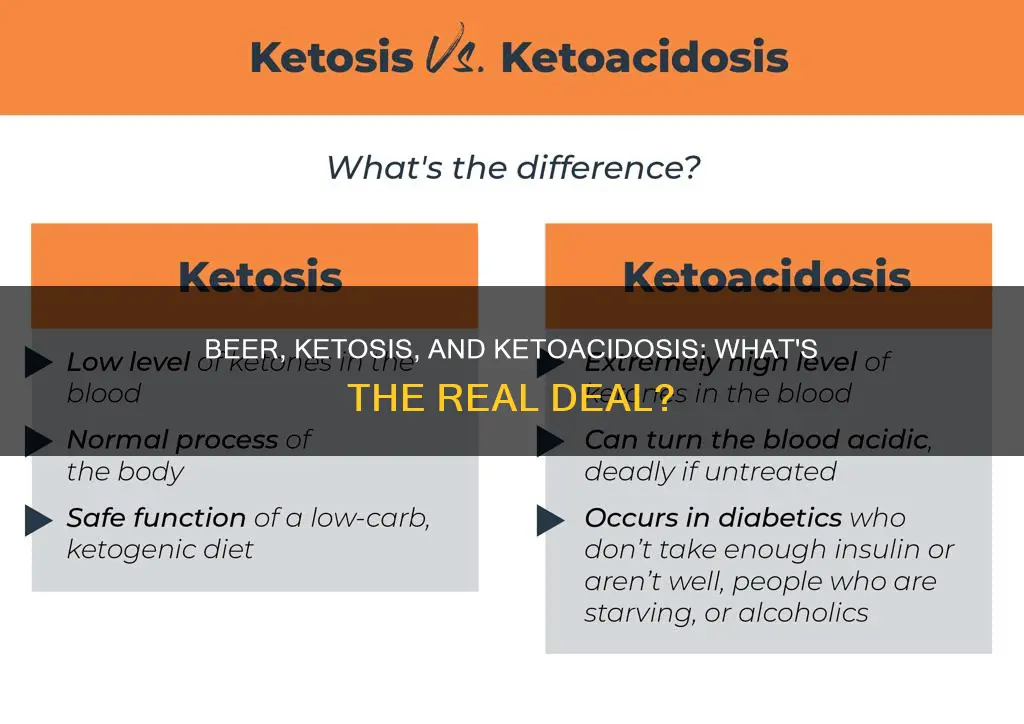
Alcoholic ketoacidosis is a dangerous condition that can be caused by heavy alcohol consumption. It is a result of the body's inability to produce insulin due to alcohol intake, leading to a buildup of ketones in the blood. This condition is often associated with malnourishment and can have severe consequences, including death. While a single drink of beer is unlikely to cause ketoacidosis, excessive alcohol consumption can lead to this life-threatening condition. It is important to understand the risks associated with alcohol abuse and seek medical attention if any symptoms of ketoacidosis are experienced.
| Characteristics | Values |
|---|---|
| Cause | Alcohol inhibits the body's ability to produce glucose, leading to a buildup of ketones in the blood. |
| Risk Factors | Chronic, excessive alcohol use, binge drinking, malnutrition, vomiting, liver or pancreatic conditions. |
| Symptoms | Agitation, confusion, decreased alertness, irregular/rapid breathing, dehydration, abdominal pain, hypotension, tachycardia, shortness of breath, dry mucous membranes, altered mental state, cardiac arrhythmias. |
| Treatment | Intravenous fluids, electrolyte monitoring, thiamine, glucose, medications for alcohol withdrawal and nausea. |
| Prevention | Avoiding alcohol consumption or limiting intake. |
What You'll Learn

Alcoholic ketoacidosis (AKA) is caused by heavy alcohol use
Alcoholic ketoacidosis (AKA) is a condition caused by heavy alcohol consumption. It is a form of metabolic acidosis, where there is too much acid in the body's fluids. This occurs when the body breaks down fat for energy, resulting in the production of ketones, which are acids.
Heavy alcohol consumption can lead to malnourishment, as those who drink large quantities of alcohol may not eat regularly or may experience vomiting. This can lead to periods of starvation, reducing the body's insulin production. When the body does not produce enough insulin, it cannot effectively use glucose for energy, and so it begins to break down fat cells, leading to the buildup of ketones in the bloodstream.
The risk of developing AKA is associated with alcohol abuse and is not related to race or sex. It is most common in people aged 20 to 60 who are chronic alcohol abusers but can occasionally occur in non-chronic drinkers after a binge. AKA typically develops in those who are unable to eat for a period of 1 to 3 days following a bout of heavy drinking. During this time, they may experience persistent vomiting and abdominal pain, further contributing to their inability to eat.
The symptoms of AKA include agitation, confusion, decreased alertness, rapid breathing, and symptoms of dehydration such as dizziness, lightheadedness, and thirst. It is a life-threatening condition that requires prompt medical attention. Treatment may involve intravenous fluids, vitamins, and nutrients to address malnutrition, as well as medications to manage alcohol withdrawal and prevent withdrawal symptoms.
Beer and Axes: Is It Safe to Mix?
You may want to see also

AKA is a buildup of ketones in the blood
Alcoholic ketoacidosis is a condition that can occur when someone has consumed a lot of alcohol, has not eaten much, or has been vomiting. It is caused by a buildup of ketones in the blood, which are acids that form when the body breaks down fat for energy. This happens because when you drink alcohol, your pancreas may stop producing insulin for a short time. Insulin is necessary for cells to use glucose for energy. When the body cannot use glucose for energy due to a lack of insulin, it switches to breaking down fat cells for energy. This process of breaking down fat cells produces ketone bodies, which can build up in the bloodstream if the body is not producing insulin.
The buildup of ketones in the blood can lead to a life-threatening condition called ketoacidosis, or metabolic acidosis. Ketoacidosis occurs when something that is metabolized or turned into acid is ingested, increasing the amount of acid in the system. Alcoholic ketoacidosis is specifically caused by excessive alcohol consumption and is considered an acute form of metabolic acidosis.
The symptoms of alcoholic ketoacidosis include agitation, confusion, decreased alertness or coma, irregular deep and rapid breathing, and symptoms of dehydration such as dizziness, lightheadedness, and thirst. It is important to seek emergency medical attention if these symptoms are present, as alcoholic ketoacidosis can be life-threatening. Treatment typically involves intravenous fluids and vitamins, and may require admission to the hospital, particularly the intensive care unit (ICU).
In addition to alcoholic ketoacidosis, there are other types of ketoacidosis, such as diabetic ketoacidosis (DKA) and starvation ketoacidosis. Diabetic ketoacidosis occurs when the body cannot produce enough insulin, which is often the case in people with diabetes. Similar to alcoholic ketoacidosis, the body breaks down fat as fuel, leading to a buildup of ketones in the blood. DKA is considered a serious complication of diabetes and can be life-threatening if left untreated. Starvation ketoacidosis, on the other hand, occurs most often in pregnant women in their third trimester who are experiencing excessive vomiting. This condition can also lead to a buildup of ketones in the blood due to a lack of insulin and an increased breakdown of fat cells.
Keto and Craft Beer: Is It Possible to Enjoy Both?
You may want to see also

AKA symptoms include agitation, confusion, and abdominal pain
Alcoholic ketoacidosis is a condition that can occur when someone has consumed a lot of alcohol, especially if they have not eaten much or have been vomiting. When this happens, it can cause a build-up of ketones, which are acids, in the blood.
Symptoms of ketoacidosis include agitation, confusion, and abdominal pain. Other symptoms include:
- An unusual, fruity odour on the breath, known as "alcoholic's breath"
- Decreased alertness or coma
- Irregular, deep, and rapid breathing (Kussmaul's sign)
- Symptoms of dehydration, such as dizziness, lightheadedness, and thirst
- Fatigue, slow movements
- Nausea
- Vomiting
- Abdominal pain
If you experience any of these symptoms, seek emergency medical attention, as ketoacidosis can be life-threatening.
The treatment for ketoacidosis typically involves receiving fluids and nutrients intravenously, and addressing any underlying conditions, such as malnutrition or alcohol withdrawal.
Krups Beertender: Compatible With Other Beers?
You may want to see also

AKA can be prevented by limiting alcohol intake
Alcoholic ketoacidosis (AKA) is a condition that occurs when there is a buildup of ketones in the blood due to alcohol use. Ketones are a type of acid that is produced when the body breaks down fat for energy. This happens because alcohol consumption can cause the pancreas to temporarily stop producing insulin, a hormone that helps glucose enter cells in the body to be used as fuel. When the body doesn't have enough insulin, it starts breaking down fat for energy, leading to the buildup of ketones.
AKA is typically caused by excessive alcohol consumption over a long period of time, often resulting in malnourishment. People who drink heavily may also experience vomiting and a decreased appetite, leading to periods of starvation that further reduce the body's insulin production.
The symptoms of AKA include agitation, confusion, decreased alertness, irregular breathing, and symptoms of dehydration such as dizziness, lightheadedness, and thirst. It is a life-threatening condition that requires immediate medical attention.
To prevent AKA, it is important to limit alcohol intake. For those struggling with alcohol addiction, seeking professional help is crucial. This may involve medication, therapy or counseling, and support groups. By reducing alcohol consumption or eliminating it altogether, the risk of developing AKA can be significantly reduced.
In addition to limiting alcohol intake, maintaining proper nutrition and a balanced diet is essential for preventing AKA. Ensuring that the body has sufficient glucose and insulin levels helps to regulate blood sugar and reduce the risk of ketoacidosis. This includes eating regular meals and avoiding prolonged periods of starvation or malnutrition.
By addressing alcohol consumption and improving nutritional intake, individuals can effectively prevent AKA and reduce the risk of life-threatening complications associated with this condition.
Beer and Gleevec: A Safe Mix?
You may want to see also

AKA is treated with IV fluids, electrolyte monitoring, and thiamine
Diabetic ketoacidosis (DKA) is a serious complication of diabetes, specifically type 1 diabetes, and less commonly, type 2 diabetes. DKA occurs when the body cannot produce enough insulin, causing a buildup of acids in the bloodstream known as ketones. If left untreated, this buildup can lead to DKA, which can be life-threatening.
Treatment for DKA typically involves addressing the underlying causes and normalising blood sugar and insulin levels. This includes the administration of fluids, electrolytes, and insulin.
IV Fluids
When a person is experiencing DKA, they lose a lot of fluids, which can reduce blood flow in the body. Therefore, one of the first steps in treating DKA is to administer fluids intravenously (IV) to restore typical blood flow and treat dehydration, which can cause even higher blood sugar levels.
Electrolyte Monitoring and Replacement
Electrolytes are electrically charged minerals, such as sodium, potassium, and chloride, that help the body function properly, especially the heart and nerves. When insulin levels are too low, electrolyte levels can also drop. Thus, another critical aspect of treating DKA is electrolyte replacement, often done through an IV.
Thiamine
Thiamine, or vitamin B1, is administered intravenously as part of the treatment for alcoholic ketoacidosis (AKA). AKA is a form of DKA caused by excessive alcohol consumption, which often leads to malnourishment. Thiamine is given to address vitamin deficiencies resulting from excessive alcohol use.
The Magic Behind Beer: A Brewery Tour
You may want to see also
Frequently asked questions
Ketoacidosis is a condition where the body breaks down fat for energy, which produces ketones. If the body makes too many ketones, they can build up and damage the body, making the blood too acidic. This is a life-threatening condition.
Alcoholic ketoacidosis is a type of ketoacidosis caused by excessive alcohol consumption, usually over a long period of time. It is often associated with malnourishment due to a lack of regular eating and vomiting caused by drinking.
Symptoms of alcoholic ketoacidosis include agitation, confusion, decreased alertness, dehydration, and irregular breathing. It is a life-threatening condition and anyone experiencing these symptoms should seek immediate medical attention.
Treatment for alcoholic ketoacidosis usually takes place in a hospital, often in the intensive care unit. Treatment includes fluid resuscitation, monitoring of electrolytes, and administration of vitamins and nutrients to treat malnutrition.
Alcoholic ketoacidosis can be prevented by limiting alcohol intake. If someone is addicted to alcohol, they should seek professional help to reduce their alcohol consumption or quit drinking altogether.







